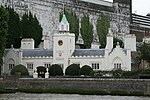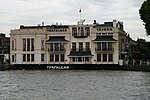Globe Rowing Club
1923 establishments in EnglandEngvarB from September 2019History of rowingRowing clubs in EnglandRowing clubs of the River Thames ... and 1 more
Sports clubs established in 1923

Globe Rowing Club is a rowing club in Greenwich in the South East of London, England. Established in 1923, the club house and boat house are based on Crane Street in the historic centre of Greenwich, as part of the Trafalgar Rowing Trust. Its crews use the River Thames and the London Regatta Centre at the Royal Docks for water outings. The club admits male and female rowers of all ages, but is particularly known for its high performance junior programme.
Excerpt from the Wikipedia article Globe Rowing Club (License: CC BY-SA 3.0, Authors, Images).Globe Rowing Club
Banning Street, London East Greenwich (Royal Borough of Greenwich)
Geographical coordinates (GPS) Address Nearby Places Show on map
Geographical coordinates (GPS)
| Latitude | Longitude |
|---|---|
| N 51.487 ° | E 0.001 ° |
Address
Sir Francis Drake Court
Banning Street 43-45
SE10 9PQ London, East Greenwich (Royal Borough of Greenwich)
England, United Kingdom
Open on Google Maps








